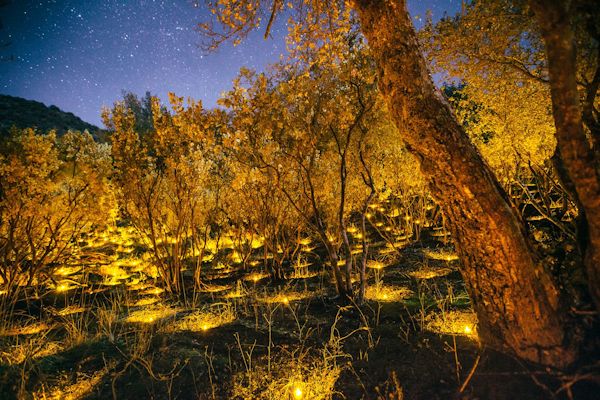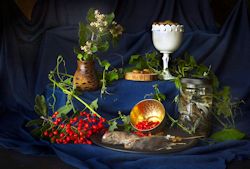SEJournal Online is the digital news magazine of the Society of Environmental Journalists. Learn more about SEJournal Online, including submission, subscription and advertising information.
 |
| Electric tea lights illuminate the locations where marijuana plants once grew in an illegal grow on national forestland in the High Sierra National Forest in California. Photo: © Morgan Heim. Click to enlarge. See a slideshow of images with her unique approach. Plus, Heim on surviving in today’s constrained news media economy and the implications for storytelling, independence and integrity. |
EJ InSight: Illustrating the Environment in a New Light
By Morgan Heim
In a photo-rich world, there are increasing pressures to do something original with your photography in order to stand out. This has pushed many photographers to make ethically questionable decisions.
There’ve been a number of instances where prize-winning images were disqualified after truths surfaced about how they were executed.
The Wildlife Photographer of the Year winner from 2017 included a shot of a stuffed giant anteater placed at the base of a termite mound in a Brazilian nature reserve.
Controversy also erupted in 2015 when the winner of the World Press Photo contest was accused of staging some of his images. He was eventually stripped of the award.
These examples are obvious violations of journalistic integrity, but what about more subjective choices?
Is it wrong, for instance, to add artificial light to dramatically illuminate your subject?
Exploring non-traditional techniques
In the new world of media, photographers can now employ creative, non-traditional techniques in unexpected situations, and we have to decide whether that is OK.
Photographer Thomas Peschak’s assignment to cover Peru’s Guano Islands for National Geographic is one example that particularly stands out.
In order to blend the past and present, Peschak lugged a projector into the field and illuminated structures and other items with images of historical photographs.
Peschak's pictures give both a sense of what it was like in the past and what these islands have become now. But the imagery is far from the norm of journalistic practice.
The resulting image illustrates a truth
that would otherwise have remained obscure
by a more traditional photojournalistic approach.
For my project about the environmental impacts of illegal marijuana grows in California’s national forests, I needed to illustrate how many plants once grew within a reclaimed site. With the plants removed, only divots remained, providing little opportunity for an exciting photo.
So I decided instead to create a data visualization photo. With the help of two others, we placed about 1,000 electric tea lights into divots where marijuana once grew, then waited for nightfall.
The resulting image creates a surreal sense of the scale of what once grew there, illustrating a truth that would otherwise have remained obscure by a more traditional photojournalistic approach.
Light painting and a Rembrandt-style tableaux
For another project, I’ve been making portraits of roadkill. The portraits look like paintings and use a technique called light painting to get soft and very specific lighting. I also place flowers around and under the animal, creating a memorial for a very formal portrait technique.
The only manipulation is the addition of flowers and lighting. The animal remains in the position and location I found it.
 |
| Yearling black-tailed deer in Warrenton, Ore., in a residential area next to the Carruthers Memorial Park road sign. The photo received honors in the 2018 Wildlife Photographer of the Year competition. Photo: © Morgan Heim. Click to enlarge. |
While clearly not photojournalism, several of these images have nevertheless been awarded photojournalism recognition in prestigious competitions like Wildlife Photographer of the Year and BigPicture Natural World Photography (Human/Nature winner for "Beast in the Garden").
I don’t think anyone would believe I’m trying to present these images as a spontaneous, captured moment. Rather, I’m making a portrait that reveals not only the subject but also the circumstances of why it’s being portrayed.
For an assignment with Audubon about island scrub jays, I wanted to illustrate the varied diets of these birds, numbering only about 2,500, that live on only one of the Channel Islands in southern California.
Despite their numbers, they are considered ecosystem engineers that literally shape their environment. Although a single island scrub jay can stash up to 4,500 acorns in a year, they actually have a wide and diverse diet.
I could've portrayed it by photographing each food source against a white background, but wanted something a little more creative. So instead, I devised a Rembrandt-style culinary portrait out of scrub jay food.
After collecting ingredients like acorns, spiny cucumber and Christmas berry in the field, the natural history collection at UC Santa Barbara provided stuffed deer mice and jars of lizards. All of it was arranged in a tableau of food, complete with blue velvet, fancy goblets and soft window lighting.
Nobody is going to think this is how scrub jays eat, so I feel safe taking this creative approach to an otherwise static subject.
 |
| Acorns are not the jay's only diet. They have a diverse palette, a sampling of which is shown here (clockwise from top left): lemonade berries, vines of wild spiny cucumber, acorns, side-blotched lizards, deer mice and Christmas berry. Photo: © Morgan Heim. Click to enlarge. |
Photographing with integrity
While we seek new ways to photograph our stories, we have to remember to do so with integrity.
There are limits regarding truth and journalistic conventions, but new methods are helping us illustrate concepts revealed by our reporting in equally truthful, but unconventional methods (in fact, I often like to think of it as photographic data visualization).
In the meantime, I’m enjoying the ways the evolution of photography is pushing me to see environmental stories in a new light.
Morgan (Mo) Heim is a senior fellow with the International League of Conservation Photographers and a former board member of the North American Nature Photography Association. She has worked on two National Geographic-granted projects, one on urban coyotes and the other for the feature film, “Deer 139,” following the migration of a single, pregnant mule deer across Wyoming. Her photos and writing appear in outlets such as BBC Wildlife, Smithsonian, Nature Conservancy, World Wildlife, Newsweek and Playboy. Her film collaborations have appeared in Banff Mountain Film Festival, Adventure Film, Telluride and the International Wildlife Film Festival. In 2016, “The Snow Guardian” received second place recognition in the Film4Climate Competition in association with COP22 and has since gone viral.
* From the weekly news magazine SEJournal Online, Vol. 5, No. 9. Content from each new issue of SEJournal Online is available to the public via the SEJournal Online main page. Subscribe to the e-newsletter here. And see past issues of the SEJournal archived here.














 Advertisement
Advertisement 



